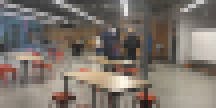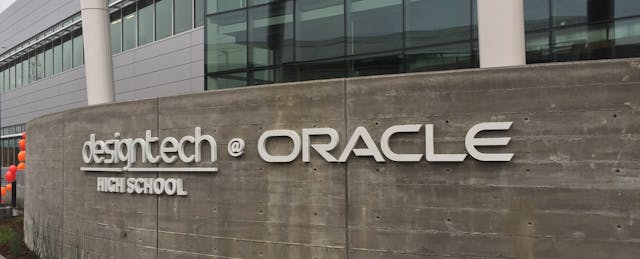Technically, today wasn’t Nick Hom’s first day of school. But it was the first day he and his classmates were united in the newly-built campus of Design Tech High School, a free public charter school founded in 2014.
Students, parents, educators and Oracle employees gathered today in Redwood City, Calif. for the school’s ribbon-cutting ceremony to celebrate the official opening of the school’s permanent home on Oracle’s corporate campus.
“I’m just glad that I get at least one semester here at this campus,” said Hom, a senior who later gave a speech to the crowd.
Also called d.tech, the school had been operating out of temporary campuses nearby in Burlingame and Millbrae. This current school year was the first year that the school had a full student body across grades 9 to 12, but the students had to be split up across different facilities due to space constraints.
The school currently serves 550 students, of whom 11 percent are on free or reduced lunch, according to Oracle spokesperson Jessica Moore. In November 2016, the school board approved a preference in the lottery for students who quality for free and reduced lunch, she added.

At the event, Oracle co-CEO Safra Catz extolled “the public-private community partnership” between the company and the school as a way to “bring the best resources to our students.” She called the students ambassadors for the future of education, and thanked the d.tech community for letting Oracle be part of “this amazing journey.”
“It has been truly the highlight of so many employees and people involved,” Catz said. In her words, d.tech aims to be “a school where students learn not what to think but how to think, to learn how to see into the future, to design solutions to problems that are only starting to show up, and to mind their own imagination and intelligence to find a way to make the world better.”
That focus on design is a key theme that runs across the campus and the curriculum which, according to the school’s website, uses a design thinking approach similar to that taught at Stanford University’s Hasso Plattner Institute of Design. First-year d.tech students take a primer course introducing them to the principles behind design thinking, which emphasizes understanding the needs and pain points of users as a core part of solving a problem.
Perhaps it’s no coincidence that design thinking is also popular among startups and technology corporations alike, including Oracle.
Galen McAndrew, a teacher at d.tech, told EdSurge that design thinking offers students a different approach to solving problems in a variety of subjects, like math and English.

McAndrew used an example of a student writing an essay in an English class. The pupil would identify the “user” as the audience, and the “problem” as the message that the student is trying to send by writing the essay. He or she would think about using different brainstorming skills to say “what could the conflict be.” With design thinking, says McAndrew, the school pushes students to think about problems and approaches that are constantly evolving, instead of the mindset that “there’s only one answer.”
Nick Hom, the student, said the school emphasizes the empathy aspect of the design thinking process—“really being able to understand your user and really get into their shoes.”
Hom said design thinking principles are also applied in regular classes on a day-to-day basis. Teachers are constantly checking with students to learn what is and isn’t working with their classes.
“They make a huge effort to try and tailor classes to you,” he added.
Jadene Auerbach, another senior at d.tech, told the audience her education has been enriched through academics, her teachers and an “intersession,” which is a two-week period held four times a year where students take a break from their core classes and go around the Bay Area to gain experience from professionals in different fields.
These intersessions offer opportunities for the most direct contact between Oracle employees and students. Colleen Cassity, the executive director of the Oracle Education Foundation, said that through the Oracle Education Foundation’s program, employees spend 30 hours with students in Oracle Education Foundation Classes, which teach skills like coding and user-centered design. The Oracle Education Foundation runs multiple classes concurrently.

Other companies, as well as non-profits, can also run classes during intersessions. Students’ options include learning about photography and financial literacy. The students also get to intern in various business units at Oracle, and at other companies and organizations around the Bay Area.
“The Bay Area really becomes students’ classroom during intersession,” Cassity said.
Cassity added that through the Oracle Volunteers Program, Oracle employees will have traditional volunteering opportunities at the school, such as math tutoring. But what the school is more interested in is “leveraging the expertise of Oracle employees that might not otherwise be available,” like an economics teacher inviting someone from the company’s finance department to talk to students.
But there are boundaries between employees and students. Oracle staff “can’t just walk into the school without purpose,” said Cassity, and while students will be traveling across the campus, they’re not allowed to go to Oracle cafes or use the gym unless they’re accompanied by “a Design Tech High School staff person or an Oracle employee in those very intentional ways.”
And while from now on students will be on the Oracle campus, roaming the halls and sitting in classrooms at d.tech, Ken Montgomery, the school’s co-founder and executive director, told the audience that moving into the building is not “our final accomplishment, but the first day of our next growth spurt.”
“We are not fully ready for all the opportunities in front of us, but I have no doubt that we will grow to meet these challenges.”


